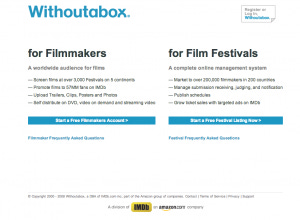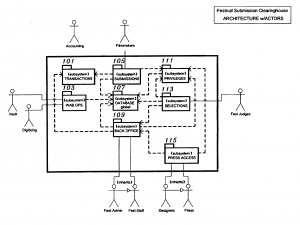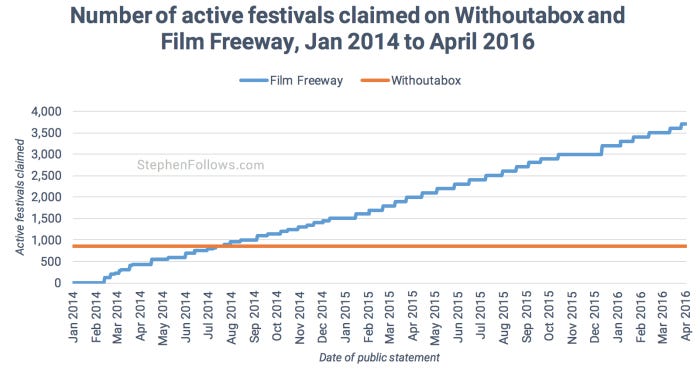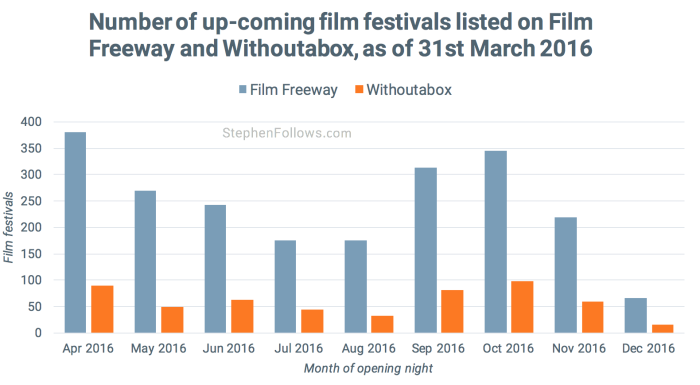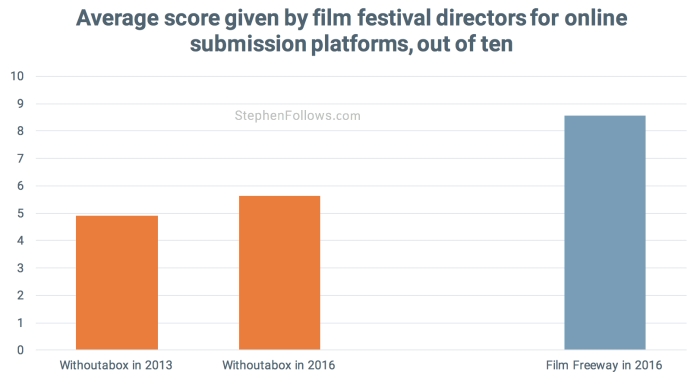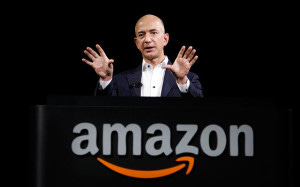Today's article can be seen as a morality tale for modern times... it contains everything you would want from a classic yarn – heroes, villains, heroes who become villains, abuse of power and a David and Goliath struggle, all in pursuit of spreading art to the people of the world. Today's piece is a bit longer than my average article but I promise it's worth it. So, if everyone is sitting comfortably, I shall begin...
'Film festival' means different things to different people. Film audiences see it as a chance to view new and exciting work from all over the world, way before it will be on general release and sometimes there are chances to see films that won't ever be released. For filmmakers, festivals are a way of showing your work, gaining recognition and connecting with other filmmakers. Film business professionals often use film festivals as a place to network, learn and find new potential films or partners to do business with.
Some film festivals are very small, running for a day or two and showing films for free to small audiences, while others have grown into huge operations, attracting tens of thousands of people. When I last studied the topic three years ago, I found 9,706 film festivals which had run at least once between 1998 and 2013, of which 2,954 had run in the previous two years. I looked at their location, dates, rules, funding, fees and shared the views of 523 film festival directors.
Since then, I have sporadically looked at individual film festivals and awards such as Cannes (1, 2, 3, 4, 5), Berlin (1, 2), London, the Oscars and the BIFAs, but I have not revisited at the overall state of film festivals.
I decided to check in and see if anything had changed since the study and, wow, things have really changed in just a few years.
How festivals find their films
An essential part of running a film festival is being able to attract new films to screen each year. The more prestigious your festival is, the more filmmakers will submit their film. In my 2013 study, I found that around two thirds of festivals charge filmmakers a submission fee when they send their film in to be considered. These fees offset the cost of reviewing films, and for many festivals are an essential part of their economic survival.
As you may expect, almost all submissions are currently made online, and it's here that our dramatic tale takes place. Twenty years ago, all submissions were handled offline and physically. This was a frustrating, slow and expensive process.
Withoutabox to the rescue!
And then, in 2000, along came Withoutabox. *insert angelic chorus* Withoutabox was such a breath of fresh air for filmmakers as they solved many of the biggest problems in making multiple submissions to film festivals....
You could add your film's details to the site just once, no matter how many festivals you wanted to enter.
You could then search, filter and select film festivals from all over the world from your computer.
Their site would automatically tell you if your film was eligible for each festival strand by comparing the festival criteria to the details of your film.
Once selected, you could apply and pay for submission from the same site, at once, in your own currency. You would then send off the VHS (later the DVD) copy of your film to the festival(s) with just the Withoutabox reference (no paper forms, etc).
Finally, the festival would display when your film had been received, when it was 'in the system' and the final outcome of your submission.
In the modern world, this is the kind of service we expect from all submission sites, but try to think back to what filmmakers faced pre-2000 and you can appreciate how revolutionary Withoutabox was. In fact, they were so new that they filed for a patent. I doubt if many users even knew that Withoutabox had a patent, but it was this granting of a patent in 2004 that would go on to cause so much pain for the film festival world.
By 2008, Withoutabox had grown to become a major force, with 125,000 filmmakers using their site to submit to over 2,000 film festivals. Thanks to this success, that year Withoutabox was bought by the Internet Movie Database (IMDb) for a reported $3 million.
This was welcomed by filmmakers as it meant that it was much easier for them to add their films to IMDb, gaining all-important industry credits on the de facto database of record. Interestingly, IMDb's history mirrors that of Withoutabox, albeit ten years earlier. IMDb came to life in 1990 as a usenet board and by 1998 had grown into the world's largest film directory when it was bought by Amazon.
So, both were started by film fans, both used the internet to solve problems for filmmakers and both were bought out eight years after their launch. However, there is one big difference - the film fan who founded IMDb, Col Needham, is still in charge of the company and works to keep it in line with the original ethos which made it succeed in the first place.
By contrast, only a few years after the sale, all of Withoutabox's founders had left the company.
The honeymoon was over for festivals
Even before the sale to IMDb, filmmakers were starting to voice their concerns about Withoutabox as their system was clunky, slow and relatively buggy. I ran a film festival around this time and we repeatedly found that our festival details had been wiped over with old information.
In addition to technological struggles, the payments system was hugely unpopular. If film festivals wanted to accept free submissions then they would be charged an upfront fee of $2,000. Festivals which charged submission fees (as two thirds do) were charged a commission of up to 18%, plus an upfront fee in the region of $500 to $1,500.
Festivals could reduce the commission if they purchased advertising packages, costing between $300 and $3,500. This meant that the smaller festivals which couldn't afford the advertising packages ended up paying the highest commission. Festivals were required to give a "discount" of five currency points to filmmakers using Withoutabox (so a UK festival would be required to drop the submission price from £15 to £10).
While this sounds like a move to help filmmakers, in fact it had the effect of causing 'standard' submission fees to rise. In addition, Withoutabox members only benefited from this "discount" if they had bought a premium package costing between $160 and $400 to upgrade their account - none of this revenue was passed on to festivals.
If a member submitted to a festival without an upgraded account, then Withoutabox kept those five currency points, on top of their commission fees. All this meant that if a festival wanted to charge £25 for submissions then they would end up with just £16.40 (£25 minus £5 and 18% fee).
Finally, festivals were required to sign exclusivity deals, meaning they couldn't use other companies which provided core services similar to Withoutabox, such as handling submissions.
When festivals experimented with other services (in addition to Withoutabox, not instead of them), they would receive strongly worded missives making it clear that if they did not desist then they would no longer be able to use the Withoutabox platform.
Filmmakers also fell out of love with Withoutabox
Withoutabox's restrictions were also felt by filmmakers. The site's biggest technology upgrade was the addition of a video streaming service which allowed film festivals to watch submitted films online rather than asking for DVD copies, called "Secure Online Screeners" (referred to by Withoutabox as S.O.S., seemingly without irony).
It was hardly groundbreaking: launched in December 2009 it came five years after the birth of Vimeo and was extremely temperamental. Filmmakers had a hard time uploading their films, festivals struggled to watch them back and there were complaints that it was slow and prone to crashing.
Buried within the filmmakers' agreements were incredibly broad clauses which gave Withoutabox an almost unrestricted right to do anything they wanted with filmmakers' films.
Some of these rights were irrevocable and included giving Withoutabox the right to re-license the films to third parties. One such clause read as follows...
You grant us a nonexclusive, royalty-free, worldwide, perpetual, irrevocable, and fully sublicensable license right to use, copy, reproduce, transmit, modify, adapt, publish, translate, create derivative works from, distribute, and display any information, data, Work, or any other information associated with your Work (collectively the “Submitted Materials”) you submit to us via the Services in any media or format.
Withoutabox shifted from liberator to captor
So, to recap, we have...
A bad, buggy site
Large upfront fees for film festivals
High commission fees
Forced discounts, which were only passed on to filmmakers if they sign up for paid plans
Anti-competitive practices
Grabbing unnecessary rights from filmmakers
Anger and frustration within the film festival community grew. When I surveyed film festival directors in 2013, Withoutabox received scathing reviews. I asked the festivals to rate Withoutabox out of ten and it received low scores across the board. The categories were value for money (4.2 out of 10), customer service (4.6 out of 10), ease of use (4.5 out of 10) and overall (4.9 out of 10). Here is just a taste of what they said...
If there were one piece of advice I would give a beginning film festival promoter, it’s avoid Withoutabox like the plague.
We stopped using [Withoutabox] this year after 8 years because we felt that for the number of entries, it wasn’t worth what we were losing to them. including our package fee and the 18% cut per entry, we only took home about 57% of our fees, to get about 350 entries.
Withoutabox is the ugliest monopoly in the festival scene, and they keep your entry fees artificially high. Before a festival has even received a single submission, they’ve already spent thousands on Withoutabox for basically an entry system that hasn’t significantly improved in years.
And it wasn't only filmmakers and film festivals which had woken up to how bad Withoutabox was, the US authorities also took note. The Federal Trade Commission opened an investigation and interviewed a number of film festival directors, focusing on Withoutabox's anti-competitive practices around exclusivity. Despite this growing rage, Withoutabox stayed the same. Their system was not overhauled, their prices did not change and it was business as usual.
Why did nothing change?
If everyone was so unhappy with Withoutabox, how did they get to keep their crown as the pre-eminent submission site for film festivals? Because they owned a patent.
Within a few months of launching in 2000, Withoutabox filed for a patent, which was then granted in 2004. The wording is incredibly broad, and the summary is...
Internet-based film festival digital entry and back office services suite model. A new computerized methods using a database system on a global network to administer film festivals. The methods include the filmmakers inputting film information into the database, which information becomes available to selected film festivals. The system preferably handles multiple submissions to different festivals, processes applications, provides simultaneous judging of a competition, and schedules film play times at the festivals.
So if you wanted to create an internet-based film festival submission service then you would have to contend with Amazon's lawyers.
A few plucky sites tried, but challengers had to contend with two lines of attack: legal attention from Amazon (such as the pressure which closed Submissions 2.0) and the festivals who used any new site also got squeezed (such as those who used Indee.tv and were told by Withoutabox that they must "deactivate all third party submission services in order to avoid disruption to your Withoutabox service"). And this worked; Withoutabox continued to provide a poor service, was widely disliked and yet kept a virtual monopoly.
FilmFreeway to the rescue!
In late 2013, the following tweet heralded the emergence of a new player on the scene...
The game is about the change. Finally, a free and user friendly alternative to Withoutabox for filmmakers. Launching January, 2014.
— FilmFreeway (@FilmFreeway) November 16, 2013
FilmFreeway was a Canadian company who had decided to take the plunge and go head-to-head with Withoutabox. Their reasons for not fearing Withoutabox / Amazon's patent were threefold...
Location - The patent is only valid in the US and as FilmFreeway is a Canadian company it didn't restrict their non-US operations. Some smaller European festival submission sites had taken advantage of this in the past but failed to gain a significant market share, thanks in part to Withoutabox's aggressive exclusivity arrangements.
Willingness to challenge the broad nature of the Withoutabox patent. In the late 1990s, a flurry of extremely broad software patents were issued by the US Patent Office which were later successfully challenged in US courts (not least Alice Corp Vs CLS Bank). These cases opened the door for FilmFreeway to claim that the Withoutabox patent did not meet the newly tightened requirements in order to be defendable. It's unclear if they ever actually had to make such a defence, but knowing that they could gave them, and other festivals, confidence that FilmFreeway was not just a flash in the pan.
Design - Finally, FilmFreeway claim that they have engineered their system in a way that does not infringe the Withoutabox patent. Their founders have a background in software development so this is certainly credible, although it must have been a tough ask considering the broad patent wording.
If back in the year 2000, Withoutabox was the perfect solution for the modern filmmaker's festival submission issues, then FilmFreeway was a perfect solution to the issues of the modern filmmaker.
They offered a reliable, fast, online video screener system and they didn't charge filmmakers for using it. At the time, Withoutabox was still charging $2.95 per submission (not per film, this was every time you used the online screener service to submit your film) and were not yet in HD, much to the chagrin of filmmakers.
The FilmFreeway interface felt modern and was quick to use. By comparison, the Withoutabox system was based on the same basic code used when the site had been launched fourteen years earlier in 2000.
In 2011, festivals had been told that the Withoutabox technology would be revamped but that was later put on hold. Therefore, it wasn't hard for FilmFreeway to seem like the knight in shining armour. Festivals also loved their pricing strategy as they offered completely free listings to festivals without submission fees (unlike Withoutabox who were charging up to $2,000) and their fees were under half of what some festivals paid Withoutabox.
FilmFreeway charged festivals 8.5% of submission fees processed, although this could be reduced to 7% in return for a tweet and a logo on the festival page. Taking a lesson out of Withoutabox's playbook, they offered their lowest rate (5%) to festivals who exclusively use their services.
This fresh, modern approach was also carried over into their marketing. A typical Facebook message from March 2104 read "Innovate or be relegated to obsolescence. #Blockbuster #MySpace #Withoutabox".
FilmFreeway shouted about the number of festivals they had signed up, and made a lot of noise as they closed in on Withoutabox's total.
They even bragged about how much faster their site was compared with Withoutabox. In 2014, one of Withoutabox's original founders, David Strauss, reached out to FilmFreeway, suggesting a joint venture for his new project. FilmFreeway declined the partnership offer, but never ones to shy away from a marketing opportunity, they tweeted a copy of his email.
CHECK THIS: The founder/CEO of Withoutabox tried to get FilmFreeway to partner up. Um, yeah, no thanks. We're good :) pic.twitter.com/chijDG3hqN
— FilmFreeway (@FilmFreeway) 20 November 2014
The new kid on the block
Filmmakers and festivals alike loved this bold, innovative new player in the film festival market. Some were dying to leave Withoutabox, while others stayed with Withoutabox but benefited from the effects of actual competition in the marketplace. FilmFreeway's web traffic grew, as shown below via each site's Alexa Rank.
The Alexa Rank measures the popularity of websites based on traffic, with the most popular website in the world (currently Google.com) having an Alexa Rank of 1. FilmFreeway first appears in the Alexa data in February 2014, when it was ranked 19,479,271th in the world, compared with Withoutabox's rank of 45,416. FilmFreeway quickly gained more traffic and overtook Withoutabox in early June 2015.
At the time of writing, FilmFreeway has an Alexa Rank of 45,748 and Withoutabox is at 62,737.
Withoutabox fought back
Withoutabox made efforts to reclaim their dwindling market share, including...
Reducing their fees to festivals, eventually matching those of FilmFreeway.
Dropping charges for 'free to enter' festivals.
Dropping set-up fees.
Removing exclusivity clauses.
Upgrading their online video screeners.
Altering the small print on filmmaker agreements to stop grabbing rights.
Updating their site, although it appears to be more of a cosmetic change as their core system and festival-side is the same as it was in the early 2000s. They still admit that their site will cause "certain errors" if you use "Internet Explorer, Chrome, or Safari".
They even ran Google Ads targeted at people Googling the phrase "Filmfreeway".
But the genie was out of the bottle and the anger and frustration that had been building for over a decade manifested as an exodus from Withoutabox to FilmFreeway.
Festivals flocked to FilmFreeway
Using public statements by the two companies (i.e. Withoutabox's declarations on their website and the FilmFreeway Twitter feed) I was able to track how many active festivals each had available to filmmakers at any given moment.
In July 2006, Withoutabox claimed to have 500 active festivals and by January 2008 they put the figure at 700.
The next public figure I could find was in January 2012, when the number of active festivals had risen to 850.
They have not publicly revised this figure since then. FilmFreeway by contrast, have been regularly tweeting about their growing festival roster and as a result, much more detailed data is available.
In order to do more detailed primary research, I measured the number of festivals which are due to open in the remaining months in 2016. Withoutabox have 535 film festivals listed to take place between 1st April 2016 and 31st December 2016. By contrast, over the same period FilmFreeway have 2,187 festivals, just over four times more.
What do film festival directors think of this revolution?
Another way of taking the temperature of the film festival world is to speak to the people who run the festivals. Last month, I contacted as many film festival directors as I could, with 395 eventually sharing their views. Withoutabox achieved a higher rating than they did in the previous study: in 2013 they received 4.9 out of 10 whereas this time they received 5.6 out of 10. However, FilmFreeway came out on top, with an average of 8.6 out of 10.
What does the future hold for film festivals?
The Withoutabox patent is set to expire on 6th June 2022, so we can expect a flood of film festival submission services in the near future.
Or perhaps the success of FilmFreeway will embolden others to bring forward their plans and launch other rival services before then. What is certain, however, is that Withoutabox's stranglehold on the sector is well and truly over.
Never again will film festivals or filmmakers have to contend with an overbearing monopoly controlling their submissions. FilmFreeway may be the first new entrant to truly match Withoutabox, but they most certainly won't be the last.
Some other film submissions sites are already available, including Festhome, Reelport, Short Film Central, Short Film Depot, Click for Festivals, Film Festival Life, Festival Focus and MoviBeta, although none have the size and scope Withoutabox once had, and that FilmFreeway has right now.
In addition, I personally know of a number of groups and individuals who are planning to launch online services aimed at some aspect film festival market, and there are no doubt many more that have yet to tip their hand. So, in pursuit of helping the sector catch up for lost time, I asked my festival directors what innovations they want to see next. Here are the most requested features, in order of popularity...
Customisable submission forms. Numerous festivals complained that they did not have enough control over their online submission forms.
Technology to manage the judging process. Each festival seems to invent its own system for assigning films to judges and tracking their feedback and so many requested a tailored system.
An active filmmaker community. Festivals felt that they lacked a single space online where they could connect with filmmakers. Some cited Withoutabox's large filmmaker database as the main reason they remain listed.
Inter-festival collaborations. Many of the problems that film festivals face will already have been solved by other festivals and therefore the directors are seeking a way to connect and exchange ideas.
Improved scheduling and management software to track submissions, prints, venues and tickets.
Epilogue
So there you have it - a story of youthful innovation turning into corporate dominance, only to be toppled by another generation's youthful innovation.
I won't lie, a part of me kind of hopes that FilmFreeway become an evil corporate behemoth, if only for the narrative symmetry and so I can write another article like this one in a couple of decades time. The only thing that still puzzles me about this story is what the strategy was within Withoutabox / IMDb / Amazon.
How many top level people knew what was really going on? I'm sure Withoutabox staff knew how poor their systems were and how much their fee structure was hated, but did they tell their bosses at IMDb? And did they in turn pass it up to Amazon?
It could be the case that the decision-makers at the top only discovered the true extent of the problems when FilmFreeway seem to effortlessly take away their entire business overnight.
Or, maybe everyone did know, but Amazon decided not to spend any more money and to just ride the patent out until it expired in 2018: a slow death at the expense of the filmmaking community. Who knows.
The truth is out there but until enough time passes that people are willing to talk openly, it will have to wait for another day...
NEW UPDATES TO THE STORY
9pm Monday 4th April: Since publishing this article I have been contacted privately by a number of people with interesting stories to tell – some staff ex-members, some festivals and some filmmakers with unique experiences. I’m still fact-checking of the new bits of information but one that I can share now is that a number of high profile festivals are still under exclusive contract to Withoutabox in return for favourable terms. The agreements are private (hence why I’ve agreed not to name names) but their agreements state that...
[Withoutabox will be] the exclusive, third-party, on-line system for accepting and processing films submitted.
So if you were wondering why some big festivals remain only on Withoutabox (rather than listing on both Withoutabox and FilmFreeway) then this could be one reason why.
Notes
I work hard on this blog to give the facts fairly and without bias. I sometimes add my own point of view, but hopefully it's clear what's fact and what's conjecture, and also that my opinions don't colour the findings.
To this end, I tend to over-explain my methods and list the limitations to any findings. Above and beyond all topics, film festivals are the hardest to maintain a measured neutrality.
Not because I have especially strong views (I don't) and not because I feel I'm skewing the results (again, I'm not), but because so many of the facts stack up in one direction. It's like the Stephen Colbert joke about how facts have a well known liberal bias, and as you've read above, the facts overwhelming support FilmFreeway.
So, for the avoidance of doubt, here are some notes on today's research which should speak to any concerns people have about my aims, methods, bias, etc...
I have not been paid by either Withoutabox or FilmFreeway. Not in any way (i.e. cash / goods / tweets / hookers / blow / etc), not directly or indirectly and have received no benefit from either company or their people.
This not an advert, advertorial or anything other than a wholly independent article which reflects the real views of the people I interviewed.
As a filmmaker I have used Withoutabox a number of times (although not recently) and I also ran a small film festival via Withoutabox five or so years ago. I have not used FilmFreeway, either as a filmmaker or from the festival point of view.
I am happy to change any errors, and to add any commentary from any relevant party. Just drop me a line on my contact form. Alternatively, leave a comment below.
I have repeatedly reached out to Withoutabox for an interview but have been bounced between press offices, before finally being told by IMDb's Head of PR...
Thank you for your interest in Withoutabox. Unfortunately, we are not able to make someone available to speak with you at this time. We do appreciate your interest, though.
I also approached a very senior person at IMDb via a mutual friend, but I have not received any reply. I am still happy to hear from Withoutabox and would love to interview anyone there. If you work for IMDb or Withoutabox then please do get in touch.
Rather fittingly, my own interactions with the two companies have reflected the wider truth - Withoutabox have been slow, unresponsive and ultimately refused to help, while FilmFreeway have been open, courteous and helpful.
I did manage to speak to a current FilmFreeway staff member, and a couple of ex-Withoutabox staff, for background research and fact-checking. I'm grateful for their time and their candor, because some of the elements in the story relied on their information and corroboration.
Working out exactly how many festivals were historically available via Withoutabox was a challenge. I used the Web Archive to look at old press releases and updated text on their website, but they have been fairly inconsistent, both with the figures and with the language used to describe what the figures related to. For example, a press release on 17th July 2006 put the total number of festivals at 500, whereas another press release the very next day put it at 600.
Also, the way they described their stated numbers adds some confusion. For example, in January 2006 a press release included the phrase...
In operation since 2000, the Company first developed and patented The International Film Festival Submission System, currently connecting more than 75,000 filmmakers in 200 countries and 1,800 film festivals.
Whereas just six months later a new press release announced...
The Company's signature product, the International Film Festival Submission System, is now in use by more than 500 festivals worldwide, growing by up to 20 a month.
I used common sense to conclude that the 500 figure relates to active festivals and 1,800 is their historical database. I used the active festivals figure (i.e. 500) in the chart showing the number of festival open to submission via Withoutabox. Their stated number of films within their database has also fluctuated hugely - in July 2007 it was at 2,765, five years later it had swelled to 8,136 but since then it has just been referred to as "more than 5,000".
Finally, please do add your thoughts and experiences in the comments below. We are entering a new phase for film festival submissions and we're all still figuring out what it means. What are your thoughts?



